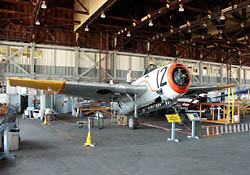
The TBM-3E Avenger, now located at Hangar No. 1 U.S. Naval Air Station Wildwood, New Jersey, is a rare extant example of the U.S. Navy's leading torpedo bomber. Throughout World War II, Avengers flew with the U.S. Navy, the U.S. Marines and the Royal Navies of the Allies in every theater of the conflict, successfully carrying out reconnaissance, bombing raids and anti-submarine patrols and contributing significantly to the eventual Allied victory. The Avenger participated in every major air-sea battle of World War II between June 1942 and August 1945, and played a significant role in search-and-destroy missions hunting German submarines, proving its worth in both night and daytime assignments. The most famous American to fly an Avenger was George H.W. Bush, later 41st President of the United States, who joined the Navy in 1942 and became the youngest naval aviator ever, at the age of 20, in June 1943.
This Avenger is a rare survivor of a type of warplane that was produced in great numbers in World War II, but of which few have survived. Of the 9,839 that were manufactured by Grumman Aircraft and General Motors, it is estimated that only 75 to 100 remain. The TBM-3E was the last Avenger model put into production during the war. It was built in 1945 in Eastern Aircraft's Trenton-Ternstedt plant outside of Trenton, New Jersey. The single-engine bomber is over 40 feet long and stands 16 feet, 5 inches high. With its wings fully extended in flying position, the airplane measures 54 feet 2 inches wide. The body and wings are made of aluminum, and the parts of the airplane that control its movement--rudder, ailerons, horizontal stabilizer and vertical stabilizer--consist of an aluminum frame covered with fabric. The engine is a Wright Cyclone engine, R-2600. It is not known if this TBM-3E Avenger was equipped with radar, since there is no evidence on the body that it was. Not found on this Avenger, but built as part of the standard body was a gunner's turret, and bomb bay doors, both of which have been removed previously. The airplane was acquired by the U.S. Navy on April 6, 1945, and was delivered in May 1945 to VT-26 (a torpedo squadron) base in San Diego, California. This Avenger remained with VT-18 for the rest of its World War II military career, but never saw action.

This TBM-3E illustrates the massive military manufacturing effort that New Jersey made during World War II. It is one of 7,546 Avengers built at General Motors' Eastern Aircraft Trenton-Ternstedt plant. Formerly used to manufacture and assemble General Motor's automobiles, the plant was converted in 1942 to assemble TBM Avengers and built them from 1942 until the end of hostilities in 1945. In recognition of its great effort to produce war materials, the Trenton-Ternstedt plant was awarded the "E for Excellence Award" for superior war production on January 2, 1945.
The use of aerial torpedoes began several years before the start of World War I, when U.S. Navy Admiral Bradley Fisk (1854-1942) patented the first one in 1912. The British Naval Air Service was the first to use torpedoes from airplanes in World War I, although American development of aircraft carriers was concurrent with those in Europe, and as they developed, so did a new breed of aircraft--the torpedo bomber. The U.S. Navy's first torpedo aircraft were twin-engine converted Martin TM-1s, modified Army bombers, but in the 1930s, Douglas Aircraft Company introduced the first TBD Devastator which became the Navy's leading torpedo bomber. In early November 1939, the U.S. Navy approached a number of aircraft manufacturers to design and build a replacement torpedo bomber for the aging Douglas TBD-1 Devastator and Grumman Aircraft Company received the contract. The Grumman Avenger, or Torpedo Bomber F (TBF), with F being the Navy's designated letter for the Grumman factory, was replaced by General Motors Avenger TBM, with M being the Navy's designated letter for the General Motors factory. General Motors converted automobile plants into airplane manufacturing facilities during World War II, and agreed to produce combat airplanes quickly and in quantity. On January 21, 1942, Eastern Aircraft was born, comprised of General Motors plants in Linden, Trenton and Bloomfield (all in new Jersey), Baltimore (Maryland) and Tarrytown (New York). Plants were emptied of their automobile equipment and converted into airplane manufacturing. As the war went on, streamlined manufacturing and sub-contracting increased the output of planes. By the end of the war, the Avenger had become one of the three most numerous carrier aircraft of all time. The total production of 9,839 Avengers was exceeded only by 12,570 Corsairs (a naval attack fighter) and 12,275 Hellcats (another fighter used for anti-submarine work, to provide air cover for invasion forces, and to provide close air support for ground troops).
This TBM-3E Avenger remained with the Navy until 1950, when it was transferred to the Canadian Armed Forces. In 1960, the bomber was decommissioned, and the rest of its active career was spent as a Canadian aerial tanker for firefighting and agricultural spraying. In 2001, Naval Air Station Wildwood Aviation Museum acquired the TBM-3E Avenger from Canadian Aerial Firefighting where it was known as Tanker 312 registered as CF-Mud. An anonymous private donation of $66,000 allowed Naval Air Station Wildwood Aviation Museum to purchase the TBM-3E. Shortly afterwards, the Museum received a $60,000 New Jersey special legislative grant to restore its Avenger.
Visit the National Park Service Travel American Aviation to learn more about Aviation related Historic Sites.
Last updated: August 22, 2017
